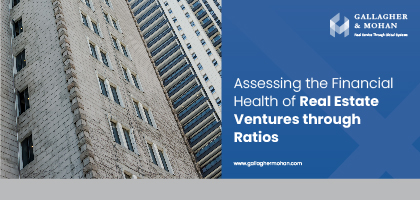11 April 2024
Assessing the Financial Health of Real Estate Ventures through Ratios
Real estate investment, often touted as a lucrative avenue for wealth creation, requires a keen understanding of financial metrics to assess its health accurately. Beyond the allure of tangible assets and potential rental income, the intricate web of financial intricacies demands scrutiny. Ratios emerge as the compass, guiding investors through the labyrinth of numbers and projections. They serve as the bridge between aspirations and realities, offering a systematic approach to unravel the mysteries of real estate ventures.
Amid the complexities of the real estate market, where every decision holds the weight of substantial investments, ratios stand as beacons of clarity. They provide investors with the means to quantify risk, evaluate profitability, and gauge operational efficiency. As the heartbeat of financial analysis, ratios illuminate the path forward, empowering investors to make informed decisions in a landscape fraught with uncertainties.
In this blog, how these numerical indicators unveil the financial health of real estate investments, enabling investors to navigate choppy waters with confidence and foresight. Join us as we decode the language of ratios and unlock the secrets they hold for savvy real estate investors.
Understanding Ratios in Real Estate
Ratios are numerical representations derived from financial statements, providing a snapshot of various aspects of a company's performance. In the realm of real estate, these ratios are instrumental in gauging the effectiveness of investment strategies, risk exposure, and potential returns. Let's delve into some key ratios commonly used in assessing the financial health of real estate ventures:
- Debt Service Coverage Ratio (DSCR)
The DSCR measures the ability of a real estate venture to cover its debt obligations with its operating income. Expressed as a ratio, it indicates the margin of safety available to lenders. A DSCR greater than 1 implies that the venture generates sufficient income to meet its debt obligations comfortably.
- Loan-to-Value Ratio (LTV)
The LTV ratio compares the amount of the loan to the appraised value of the property. It serves as a crucial metric for lenders in assessing the risk associated with the loan. A lower LTV ratio signifies a lower risk for lenders and may result in more favorable loan terms for the borrower.
- Capitalization Rate (Cap Rate)
The Cap Rate is a measure of the rate of return on a real estate investment property. It is calculated by dividing the property's net operating income (NOI) by its current market value or acquisition cost. A higher Cap Rate indicates a potentially higher return on investment, although it may also signify higher risk.
- Gross Rent Multiplier (GRM)
The GRM is used to evaluate the value of income-producing properties. It is calculated by dividing the property's purchase price by its gross rental income. A lower GRM suggests that the property is relatively inexpensive compared to its rental income, making it potentially more attractive to investors.
- Return on Investment (ROI)
ROI measures the profitability of a real estate investment relative to its cost. It considers both the income generated and any capital appreciation. A higher ROI indicates a more profitable investment.
Also Read: Handling Foreign Investments: International Real Estate Accounting
Assessing Financial Health Through Ratios
Now that we've explored the key ratios used in real estate analysis, let's discuss how these ratios collectively paint a picture of the financial health of a real estate venture:
- Stability of Cash Flow
Ratios such as DSCR and Cap Rate provide insights into the stability and sustainability of cash flows generated by the real estate venture. A healthy DSCR indicates that the venture generates sufficient income to cover its debt obligations, reducing the risk of default. Similarly, a favorable Cap Rate suggests strong operating income relative to the property's value.
- Risk Management
LTV ratio plays a crucial role in assessing the risk exposure of a real estate investment. A lower LTV ratio signifies a conservative financing approach, reducing the risk of default and potential loss for investors. Additionally, GRM offers insights into the property's affordability and potential rental income, aiding in risk assessment.
- Return on Investment
Ultimately, investors seek returns on their real estate investments. Ratios such as ROI and Cap Rate help investors evaluate the potential profitability of a venture. A higher ROI and Cap Rate indicate a more attractive investment opportunity, offering the potential for greater returns.
Conclusion
In the dynamic world of real estate investment, understanding the financial health of ventures is paramount for investors seeking to maximize returns while minimizing risks. Ratios serve as powerful tools, offering valuable insights into various aspects of a real estate venture's financial performance. By leveraging these ratios effectively, investors can make informed decisions, navigate market complexities, and unlock the full potential of real estate investments.
For expert guidance and tailored solutions in real estate investment, connect with Gallagher & Mohan today. Let us navigate the complexities and unlock the full potential of your investments. Reach out now to embark on a journey towards financial prosperity and growth.



